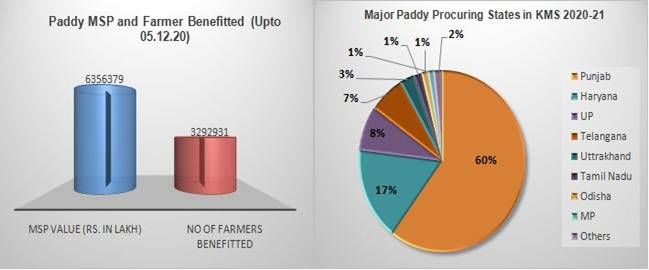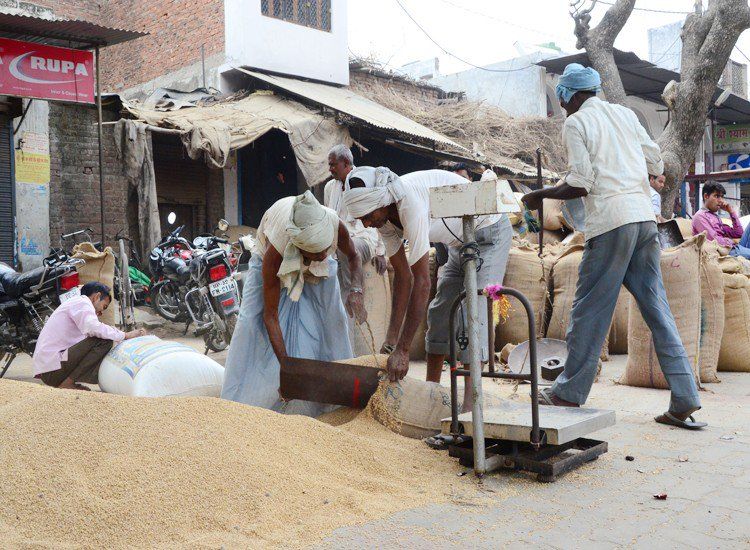Battle for MSP: Punjab and Haryana’s farmers fear their robust mandi system will collapse
The central government procured 375.72 lakh metric tonnes of paddy, nearly 54% of it from Punjab and nearly 15% from Haryana, till December 13 this year. Farmers from these states have put up a fight to save the mandis.


Farmers protesting against the three agri laws at Singhu border, Delhi. Photo: Amarjeet Kumar Singh
Lucknow/New Delhi/Sangrur/Karnal.
Why does it look like the protests against the farm laws are mostly by the farmers of Punjab and Haryana? Do they stand to lose more because of the new laws? The answer is complicated, and involves mandis and minimum support price (MSP).
What does the average Indian consume the most? Roti, rice and vegetables. And, although Punjab and Haryana consume very little rice, they grow a substantial amount of it, which is consumed by the rest of the country. The two north Indian states are jointly hailed as the nation’s food bowl, and are major producers of food grains and contribute significantly to India’s food security.
“Farming is the chief source of income for people in Punjab and Haryana, and cultivation means growing paddy and wheat, which are then procured at the government rate [MSP]. The new laws are viewed by the two states as a serious threat to their well-established system and so they are protesting,” explained Kamaljeet Singh from Chandigarh, who works towards skill development and betterment of farmers in many states.

Chet Singh, who is 55 years old, is from Mankhedi village of Hoshiarpur district in Punjab. He told Gaon Connection he recently sold 100 quintals of paddy in the mandi at the rate of 1,880 a quintal, through a broker. About 1,400 kilometres away from Chet Singh’s village lives Rajinder Singh. The 35-year-old farmer from Paliya tehsil in Uttar Pradesh’s Lakhimpur district sold his 100 quintals of paddy to a rice mill at Rs 1,300 a quintal, Rs 580 less a quintal, compared to Punjab. In Uttar Pradesh and Bihar, paddy usually sells between Rs 900 and Rs 1,300 a quintal.
The central government has procured 375.72 lakh metric tonnes of paddy from across the country till December 13 this year at MSP. Of this, Punjab contributed 202.77 lakh metric tonnes, 53.96 per cent of total procurement, and Haryana 14.9 per cent. Uttar Pradesh contributed 9.1 per cent.
Watch the video of Gaon Connection on paddy procurement
MSP is the rate decided by the central government for 23 Rabi and Kharif crops. This time, the MSP of paddy was Rs 1,888 a quintal for A-grade paddy (high quality) and Rs 1,868 a quintal for regular paddy.
Devinder Sharma, renowned food and export policy expert from Mohali, told Gaon Connection that the government officially states that only six per cent of the country’s farmers enjoy the benefits of MSP. “Most of the people forming that six per cent are from Punjab and Haryana,” he said.
In Punjab, the government procures 97 per cent of paddy and 75 to 80 per cent of wheat. It is a combined one per cent in Bihar while Rajasthan provides around 4 per cent procurement, he explained.
“Why will those who do not know about MSP or enjoy its benefit come forward to protest for it? They are already at the mercy of the open market. Had all governments developed the mandi network, these farmers too would have gotten the benefit of MSP,” Sharma explained.

In 2014, the Narendra Modi government constituted a high-level committee headed by BJP MP Shanta Kumar. The committee submitted its report on the Food Corporation of India (FCI) and MSP in 2015. As per the report, based on data released on the average sale of wheat and paddy in 2012-13, out of the 90.2 million existing farmers, only 5.8 per cent could sell their produce to government agencies at MSP. According to a NITI Aayog report on MSP, in 2016, though 81 per cent of farmers knew about MSP being given to many crops, only 10 per cent were aware of the rates before the sowing season.
Paddy is cultivated in most of the 75 districts of Uttar Pradesh (except Bundelkhand) and the government has set up 4,339 paddy procurement centres. Compare this to Punjab — in its 22 districts, 4,007 procurement centres were set up — up from the 1,850 centres before COVID-19. “It is our constant endeavour that every single grain of the farmer be purchased at MSP,” Anandita Mitra, director of food, civil supplies and consumer affairs in Punjab, told Gaon Connection.
Towards this, “state agencies are allotted the mandis well in advance. The paddy that Punjab government agencies buy through brokers reaches the FCI after being milled at 4,700 paddy mills. This time, the state procured 178 lakh metric tonnes of paddy”, she added.
As per the Punjab government data, in 2019-20, the area under paddy cultivation was 29.20 lakh hectares, up from 28.95 lakh hectares in 2014-15. Estimated production was 175.84 lakh tonnes. “Production or market surplus is based on projections,” said Mitra.
“It is only when paddy arrives at the mandi that the actual yield is established. The Punjab Agricultural University had reported production could exceed by 10.50 per cent. Secondly, brokers are common in the bordering villages of Haryana — many Punjab farmers used to sell their paddy in Haryana. This time, that did not happen, and mandis in Punjab received about 10 lakh metric tonnes of surplus paddy,” Mitra elaborated.
Also, hundreds of truckloads of paddy from UP and Bihar were purchased indiscriminately and sold in Punjab, Gaon Connection reported. So far, 95 reports have been lodged against trucks and trolleys by the mandi board in Punjab, informed Mitra.

In order to prevent paddy coming in from outside and to benefit the farmers of Haryana, the state government launched Meri Fasal Mera Byora (my crop my details) portal, in which it was mandatory to furnish one’s land details (Khasra khatauni). The move was made to prevent outsiders from selling paddy in Haryana.
In Gaon Connection’s rapid survey among 5,022 farmers in 16 states, 67 per cent of farmers were found to be aware of agricultural laws. The survey was titled The Indian Farmer’s Perception of the New Agri Laws. The farmers of Punjab, Haryana and Himachal Pradesh were the most aware and also the most vocal against the bills.
Senior rural journalist and parliamentary affairs expert Arvind Kumar Singh, who is in Ghaziabad, said that although the protest continues to rage all over the country, Punjab and Haryana are the nearest to Delhi and the highest procurement at MSP is also done in these two states.
“Punjab and Haryana may be smaller in area, but their contribution to India’s food security is undeniably major. A large segment of the underprivileged in the country is fed on ration procured from these two states. Only wheat and paddy are procured at MSP. Maize sells here at Rs one thousand two hundred rupees a quintal instead of one thousand eight hundred rupees. The people of Punjab invest a lot in farming, secure that mandis will readily buy crops. The new laws, however, threaten both the mandi as well as the MSP system,” Arvind Kumar Singh said.
Punjab and Haryana’s contribution of wheat and paddy to the central pool is the highest. This helped the government provide wheat at Rs two a kg and rice at Rs 3 a kg every month through ration cards during the Corona crisis to 800 million people under the Pradhan Mantri Garib Kalyan Yojana.

Punjab and Haryana have robust mandi systems. There are mandis every five to six kilometres in Punjab. According to a report in the Indian Express, there are about 152 major mandis in Punjab and around 28,000 registered brokers. These mandis employ up to 300,000 labourers in transportation, sorting and packing. These mandis procure from about 2 million farmers.
According to official statistics, there are 2,477 large APMC (Agricultural Produce and Market Committee) and 4,843 sub APMC in the country. As per the recommendations of the Swaminathan Commission, the country needs 42,000 mandis.
Once the farmer reaches mandi with his produce (especially wheat or paddy), it is bound to be sold at MSP. But in states other than Punjab and Haryana, there are neither such mandis nor such a robust procurement system. Mehak Singh Tarar, chairperson of Adarsh Pashupalak Society, and a farmer and herder in Shamli district of Uttar Pradesh, lauded the mandis of Punjab as revolutionary for agriculture and farmers. “Under the new laws, parallel mandis would only cause trouble. This is why farmers are agitating,” he said.
More mandis mean more income, he said. “No farmer who is hungry can fight, because he has to worry for his next meal. The farmers from Punjab and Haryana are not as hungry, and so, can fight. The rest of the farmers have been turned into labourers through government policies,” Tarar explained.
Many states produce local cash crops that are not supported by MSP and the mandi system; Punjab and Haryana are dependent on mandis. Ram Singh, who is 50 years old, made clear the importance of the mandis in their lives. Speaking to Gaon Connection at the Shambhu border of Punjab and Haryana, he said, “These laws are but a conspiracy to ruin our mandis. What happened in Bihar with the doing away of mandis, we will not allow in Punjab. ”

